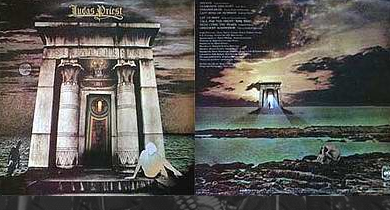aNewDomain — I listen to Judas Priest’s “Last Rose of Summer” every single August. I’m listening to it right now, in fact. I’m playing a song from the band’s 1977 “Sin After Sin“ album, and it begins with this: “Throughout the soft and timeless days of August …”
— I listen to Judas Priest’s “Last Rose of Summer” every single August. I’m listening to it right now, in fact. I’m playing a song from the band’s 1977 “Sin After Sin“ album, and it begins with this: “Throughout the soft and timeless days of August …”
Inevitably, this song leads me to listen to the whole album. (I used to own a copy of the original on vinyl. These days I listen to the remastered 2001 release with two bonus tracks on CD.)
“Last Rose of Summer” was inspired by Irish poet Thomas Moore’s “Tis the Last Rose of Summer.” You gotta love that a heavy metal band like Judas Priest wrote and recorded such a truly beautiful song, and one that’s inspired by a renowned poet, too.
The song isn’t anything like those insipid, 1980s-era hairspray metal ballads, either. It is awesome. And it features Rob Halford’s ridiculously gorgeous vocals. I’ll talk more about that virtuoso singer below.
“Last Rose of Summer” and my annual listen to “Sin After Sin” has (again) made me realize how glorious this 1977 album really is. So I decided give you a retro review. Here’s my “Sin After Sin” (1977/2001) review.

NWOBHM starts here
Before “Sin After Sin” was recorded, Judas Priest didn’t take its producer Roger Glover too seriously, as the story goes. But Glover, the former Deep Purple bassist, was instrumental in the creation of this outstanding record. Under his watch and guidance, the whole album was recorded in just six days. And it brought music and metal together in a way that was totally fresh.
“Sin After Sin” was recorded at Rampart Studios in London, UK, in January 1977, and released in April 1977.
During the recording Judas Priest was able to bring some new qualities to metal. In my view, it can be argued that the band’s 1977 album spearheaded the whole New Wave of British Heavy Metal (NWOBHM) movement, a movement that would later include such artists as Samson, Saxon, Iron Maiden, Def Leppard, Diamond Head, Angel Witch and Tygers of Pan Tang.
“Sin After Sin” also effectively introduced speedy riffs and lead breaks as a core force of heavy metal. When the album was first recorded in ’77, the musical genre we now call heavy metal had barely s urfaced. But the album introduced highly technical drumming, underpinned by double-bass-drum driving, as a consistent and expected feature in the genre.
urfaced. But the album introduced highly technical drumming, underpinned by double-bass-drum driving, as a consistent and expected feature in the genre.
And listen to that double-bass-drum driving
The drumming on the album needed to be so technical and fast for its time that the band’s drummer, Alan Moore, reportedly got fired before the album was recorded.
Now, to be objective, it must be said that since his second (and this time permanent) departure from Judas Priest in late 1976, drummer Alan Moore has been virtually untraceable. Even the band’s official biographer, author Neil Daniels, said that Moore was the only former band member whom he couldn’t trace at all. Other writers and journalists have reached the same dead end about Moore. Therefore, what prompted him to leave can’t be said for certain.
However, suggestions from music critics and from Glover suggest that Moore was fired by the band because he couldn’t keep up with the new, fast-paced musical direction. In a Metal Works video interview in 1993, Glover recalled:
I kinda became aware that any suggestion I came up with was falling on deaf ears. I’d say, ‘How about doing that riff twice?’ And they’d go, ‘Hmm’. ‘Ok, well, um, let’s move on to the next one…’ At the end of the afternoon, I was sorta getting the cold shoulder, so I kinda figured they really don’t want a producer.
About a couple of weeks later I got this phone call saying, ‘Will you come down and help us out? We’ve been in the studio for a couple of weeks and it’s not going very well’. And I guess they’d fired the drummer, so we did the album in six days with Simon Phillips, a session drummer at the time.”
Listening to the band’s previous album, “Sad Wings of Destiny,” and then to “Sin After Sin,” one could certainly draw the conclusion that Moore was let go so that the band could find a drummer more to its liking.
And so Glover and CBS Records, which had just signed the band, brought in 19-year-old jazz-trained drum prodigy Simon Phillips. After the recording sessions were over, Phillips was asked to join as a permanent member. He had to decline because of an obligation to the Jack Bruce Band.
Priest eventually hired Les Binks, one of the few drummers of those days who could handle double-bass drumming and could learn Phillips’ parts.
You can see Binks and the whole band melting faces off on its 1978 tour for the next studio album, “Stained Class:”
https://youtube.com/watch?v=GShr13m0UZ8%3Frel%3D0%26controls%3D0%26showinfo%3D0
And the formula won
“Sin After Sin” is a great rock album for a number of reasons. In addition to the technically amazing, thundering drumming there was a fantastic sense of melody and harmonies which went into the songwriting and arrangements. The album singularly proves that heavy metal can be (and even ought to be) melodically advanced, more akin to Mozart than to mindless bludgeoning. Adding to the melodic beauty of the album is a little bit of classically inspired piano playing by guitarist Glenn Tipton.
It also helped that the album featured a rearranged cover of Joan Baez’s song about Bob Dylan, “Diamonds and Rust.” The song got Judas Priest needed and desired radio play and became, probably, as much a hit song for the British musical metallurgists as it was for Baez.
For all that, the album is crushingly heavy for its day and age.
When modern thrash metal speed freaks Slayer covered one of the album’s songs, “Dissident Aggressor,” it could only be sped up by them, slightly. And it replaced some vocal parts with guitar.

This brings me to what I consider the greatest aspect of the album — Rob Halford. Singer Rob Halford is unquestionably one of the most astounding heavy metal or rock singers in history.
(For me, only Ronnie James Dio could match or best Halford when the latter was in his prime.)
Endowed with at least a four-and-a-half octave (which sounds closer to a six-octave) vocal range, as well as sheer vocal power and utterly incredible sustain capability, Halford makes “Sin After Sin” a masterpiece — not just of heavy metal, but of true art and music overall.
It was during this later 1970s period that Halford crafted his style, figuring out all of the technical capabilities and nuances of his voice. With “Sin After Sin” his deeply mined talents truly shine through.
Halford’s greatest singular accomplishment on the record is what he does with the opening song, “Sinner.” Considered an epic or gothic metal song, Halford shows off nearly the entire range of his vocal capabilities in the track. The coda of the song, which features Halford using studio overdubs to sing harmonies with himself, should make the hairs on the arms or neck of any true music lover stand up, even those who don’t like metal.
Halford would go on to be dubbed “The Metal God” by fans of Judas Priest and the heavy metal world a few years, a few albums and a few hell-bent-for-leather stage costume changes later. Listen to “Sin After Sin” and you’ll understand why.
If you’re a metalhead, a “rockaroller” or just an open-minded audiophile, this is an album you ought to listen to — if only during the timeless days of August. Here’s the album in full:
http://www.youtube.com/watch?v=tHbz2lYgqJ8&w=560&h=315
For aNewDomain, I’m Brant David.
Images in order: Sin after Sin cover via the Wayback Machine, Internet Archive, All Rights Reserved; Sin After Sin by steve via Flickr; Young Judas Priest screenshot courtesy CBS, All Rights Reserved; Basket of Judas Priest by Mary McCoy via Flickr













